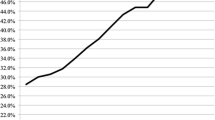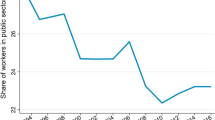Abstract
This paper examines the impact of housing tenure choice on unemployment duration in Belgium using EU-SILC micro data. We contribute to the literature in distinguishing homeowners with mortgage payments and outright homeowners. Accounting for tenure endogeneity and unobserved heterogeneity, we find that homeowners with a mortgage exit unemployment first, while outright owners stay unemployed the longest. Tenants take an intermediate position. Our results emphasize the key role of housing costs in the link between housing tenure and labour market outcomes. Considered together with the results of recent macroeconomic research on housing and employment in Belgium, this paper provides indirect evidence for significant negative effects of homeownership on the labour market and the economy beyond the owners themselves.

Similar content being viewed by others
Notes
Munch et al. (2006) only make the broad subdivision between homeowners and non-homeowners. Battu et al. (2008) split up the group of non-homeowners into public and private tenants. Brunet and Lesueur (2009) distinguish tenants and people living free of charge (mainly young people living in their parents’ home).
van Ewijk et al. (2007) raised the hypothesis of externalities from homeownership already a few years ago. The effects of ownership on the economy beyond the owners themselves that they mention, however, are mostly positive and do not directly concern the labour market. Homeowners, for example, may support local schools more and invest more in child rearing, improving childrens’ cognitive and behavioural outcomes.
Unsurprisingly, the above mentioned empirical literature studying geographical mobility leaves us with mostly ambiguous answers to the question whether outright owners or mortgagees are more geographically mobile. For example, in a cross-section of 23 OECD countries, Caldera Sánchez and Andrews (2011) find outright owners to be less residentially mobile than owners with mortgage payments in 15 countries. They observe the opposite in 4 other countries. In 4 last countries, one of which is Belgium, there is no significant difference between outright owners and mortgagees in this respect. Isebaert (2013), by contrast, uses panel data and finds mortgagees to be less geographically mobile than outright owners in Belgium. Thereby, the only robust empirical result across studies seems to be that tenants are more residentially mobile than owners.
Vastmans and Buyst (2011) reveal that monthly mortgage payments account for 24.6 % of a household’s net monthly income, on average. Housing costs of outright owners, by contrast, are limited to maintenance costs. As to the distinction between homeowners with a mortgage and tenants, Heylen et al. (2007) report a mean rental price in the Flemish region in 2005 of 396€ , while the mean mortgage payment was equal to 564€ . The latter clearly represents the heaviest burden on the household budget. Furthermore, tenants experience lower costs of maintenance. Rouwendal (2009, figure 12) reports comparable data for the Netherlands. He confirms that net out-of-pocket housing costs are clearly higher for mortgagees than for tenants, at least among young and middle-aged households.
Possible destinations are retirement, being permanently disabled or taking up domestic tasks and care responsibilities.
The only explanatory variable that we allow to vary during unemployment spells is the regional unemployment rate. This variable is strictly exogenous all the way. It contributes to the model by capturing the business cycle at the regional level. Belgium consists of three regions (Flanders, Wallonia and Brussels).
The interpolation that we impose assigns the yearly observation in EU-SILC to 6 months before and 6 months after the moment of measurement (around March). This also brings the advantage of a larger sample. When new households enter the panel in year y, data is collected also about their labour market situation in the 12 months of \({y-1}\). Spells that start in October of \({y-1}\) can therefore also be included in our sample.
Coulson and Fisher argue that regional homeownership rates may affect wage setting and other costs of doing business in a region. This may affect individuals’ chances on the labour market. The use of regional homeownership rates as instrument would then be invalid. We emphasize that our results do not in any way depend on the use of this particular instrument (see Sect. 5.2).
The hazard rate is defined as the probability to flow into employment at date \(t\) conditional on being unemployed up to \(t\). See Kiefer (1988) for an introduction into duration analysis.
To avoid cumbersome notation, we ignore that the regional unemployment rate is a time-varying covariate.
An alternative identification strategy, as used by Munch et al. (2006), Van Vuuren and van Leuvensteijn (2007) and De Graaff and van Leuvensteijn (2013) is to exploit the multiple spell feature of the data. If multiple unemployment spells are available for a specific employee and if the homeownership status of this employee varies over these spells, then the effect of homeownership on unemployment duration is theoretically identified. The existence of multiple spells ensures in this strategy that the modelled unobserved heterogeneity distribution captures “within individual” effects. However, using this strategy is not an option in our case. Only 105 individuals in our sample have two or more non-left-censored unemployment spells during their observation period. Among these 105 individuals, only six workers change their housing status.
To avoid cumbersome notation, we simplified the notation for theta.
The methodology as advocated by these authors boils down to the assumption that a sample consists of a finite number of subsamples with different levels of time-invariant unobservable effects. Then, for all subsamples the corresponding proportions are estimated as well as the impact of the unobserved differences on the outcomes.
We impose this normalisation since we allow for a constant term in the vector of observed characteristics x.
We take both the locations and the probabilities of the mass points to be unknown parameters without constraining the correlation between \(u_{1},\, u_{2,}\) and \(v\). Allowing only perfect correlation or no correlation or a priori limiting the number of heterogeneity types to an arbitrary number—the latter constraint is adopted in most of the mentioned former contributions—may lead to biased estimates, as shown by Gaure et al. (2007). The estimation procedure for gathering the probabilities and locations of the mass points is implemented according to the latter authors.
\(1-\exp (-0.50) = 0.39\).
The percentages that we mention have been derived from the EU-SILC database by Dol and Neuteboom (2009).
References
Andrews, D., Caldera Sánchez, A., & Johansson, Å. (2011). Housing markets and structural policies in OECD countries. OECD economics department working papers, no. 836.
Battu, H., Ma, A., & Phimister, E. (2008). Housing tenure, job mobility and unemployment in the UK. Economic Journal, 118, 311–328.
Blanchflower, D. G., & Oswald, A. J. (2013). Does high home-ownership impair the labor market?. NBER working paper, no. 19079.
Bloemen, H., & Stancanelli, E. (2001). Individual wealth, reservation wages, and transitions into employment. Journal of Labor Economics, 19, 400–439.
Böheim, R., & Taylor, M. (2002). Tied down or room to move? Investigating the relationships between housing tenure, employment status and residential mobility in Britain. Scottish Journal of Political Economy, 49, 369–392.
Brunet, C., & Lesueur, Y. (2009). Do Homeowners stay unemployed longer? Evidence based on French data. In C. van Ewijk & M. van Leuvensteijn (Eds.), Homeownership and the labour market in Europe. Oxford: Oxford University Press.
Caldera, Sánchez A., & Andrews, D. (2011). Residential mobility and public policy in OECD countries. OECD Journal: Economic Studies, 2011(1), 185–206.
Coulson, E. N., & Fisher, L. M. (2002). Tenure choice and labour market outcomes. Housing Studies, 17, 35–50.
Coulson, E. N., & Fisher, L. M. (2009). Housing tenure and labor market impacts: The search goes on. Journal of Urban Economics, 65, 252–264.
De Graaff, T., & van Leuvensteijn, M. (2013). A European cross-country comparison of the impact of homeownership and transaction costs on job tenure. Regional Studies, 47, 1443–1461.
Dol, K., & Neuteboom, P. (2009). Macro change and micro behaviour: The effects of aging on tenure choice, and households’ strategies towards the use of housing wealth. DEMHOW research paper, Delft.
Flatau, P., Forbes, M., Hendershott, P. H., & Wood, G. (2003). The roles of leverage and public housing. NBER working paper no. 10021.
Gaure, S., Roed, K., & Zhang, T. (2007). Time and causality: A Monte Carlo assessment of the timing-of-events approach. Journal of Econometrics, 141, 1159–1195.
Goss, E. P., & Phillips, J. M. (1997). The impact of home ownership on the duration of unemployment. Review of Regional Studies, 27, 9–27.
Heckman, J. J., & Singer, B. (1984). A method for minimizing the impact of distributional assumptions in econometric models for duration data. Econometrica, 52, 271–320.
Heylen, K., Le Roy, M., Vandenbroucke, S., Vandekerckhove, B., & Winters, S. (2007). Wonen in Vlaanderen. De resultaten van de woonsurvey 2005 en de uitwendige woningschouwing 2005. Brussel: Kenniscentrum voor een Duurzaam Woonbeleid/Vlaamse overheid.
Hughes, G., & McCormick, B. (1981). Do council housing policies reduce migration between regions? Economic Journal, 91, 919–937.
Hughes, G., & McCormick, B. (1987). Housing markets, unemployment and labour market flexibility in the UK. European Economic Review, 31, 615–645.
Isebaert, D., (2013). Housing tenure and geographical mobility in Belgium. Faculty of economics and business administration working paper, Ghent University, no. 2013/855.
Isebaert, D., Heylen, F., & Smolders, C. (2013). Houses and/or Jobs: Ownership and the labour market in Belgian districts. Regional Studies (forthcoming). doi:10.1080/00343404.2013.837873.
Kiefer, N. (1988). Economic duration data and hazard functions. Journal of Economic Literature, 26, 646–679.
Moriizumi, Y., & Naoi, M. (2011). Unemployment risk and the timing of homeownership in Japan. Regional Science and Urban Economics, 41, 227–235.
Munch, J. R., Rosholm, M., & Svarer, M. (2006). Are homeowners really more unemployed? Economic Journal, 116, 991–1013.
Munch, J. R., Rosholm, M., & Svarer, M. (2008). Home ownership, job duration, and wages. Journal of Urban Economics, 63, 130–145.
OECD. (2012). Employment outlook. Paris: OECD.
Oswald, A. J. (1996). A conjecture on the explanation for high unemployment in the industrialized nations: Part 1. Warwick economic research papers, no. 475, University of Warwick.
Oswald, A. J. (1997). Thoughts on NAIRU. Journal of Economic Perspectives, 11(1), 227–228.
Rendon, S. (2006). Job search and asset accumulation under borrowing constraints. International Economic Review, 47, 233–263.
Rouwendal, J. (2009). Housing wealth and housing portfolios in an ageing society. De Economist, 157, 1–48.
Rouwendal, J., & Nijkamp, P. (2010). Homeownership and labour-market behavior: Interpreting the evidence. Environment and Planning A, 42, 419–433.
van den Berg, J., & Holm, A. (2002). Do stepping-stone jobs exist? Early career paths in the medical profession. Journal of Population Economics, 15, 647–665.
van Leuvensteijn, M., & Koning, P. (2004). The effect of home-ownership on labor mobility in the Netherlands. Journal of Urban Economics, 55, 580–596.
Van Vliet, O., & Caminada, K. (2012). Unemployment replacement rates dataset among 34 welfare states 1971–2009: An update, extension and modification of the Scruggs. Welfare State Entitlements Data Set, NEUJOBS Special Report, n(2), Leiden University.
van Ewijk, C., Jacobs, B., & de Mooij, R. (2007). Welfare effects of fiscal subsidies on home ownership in the Netherlands. De Economist, 155, 323–336.
Van Vuuren, A., & van Leuvensteijn, M. (2007). The impact of homeownership on unemployment in the Netherlands. CPB discussion paper, 86, CPB Netherlands Bureau for Economic Policy Analysis.
Vastmans, F., & Buyst, E. (2011). Woningprijzen in Vlaanderen en de rol van de intrestvoet. In S. Winters (Ed.), Is wonen in Vlaanderen betaalbaar? (pp. 15–48). Antwerpen/Apeldoorn: Garant.
Acknowledgments
We thank Bart Cockx, Gerdie Everaert, Carine Smolders, Claire Dujardin, Andrew J. Oswald, Jan Rouwendal, Aico van Vuuren, Michael Rosholm, Tobias Brändle and two anonymous referees for their constructive comments during the development of this paper. We also benefited from comments received at various national conferences and workshops, the 2013 Spring Meeting of Young Economists (Aarhus, June 2013) and the 2013 EALE Conference (Torino, September 2013). Finally, we gratefully acknowledge support from the Policy Research Centre ‘Steunpunt Fiscaliteit en Begroting’ funded by the Flemish government.
Author information
Authors and Affiliations
Corresponding author
Rights and permissions
About this article
Cite this article
Baert, S., Heylen, F. & Isebaert, D. Does Homeownership Lead to Longer Unemployment Spells? The Role of Mortgage Payments. De Economist 162, 263–286 (2014). https://doi.org/10.1007/s10645-014-9236-6
Published:
Issue Date:
DOI: https://doi.org/10.1007/s10645-014-9236-6




